How to Grow Your Contact Database Post-GDPR
Jul 06, 2018 / By Elif Hiz
Did you know that the second most successful channel to connect with a prospect is email? Current research says by 30% - wow.
Despite the recurring marketing discussion that ‘email communications are dead,’ email has proven over and over again that it isn’t – and especially so for B2B marketers. Email remains the preferred communication channel for enterprise marketing and is still a highly effective digital outreach tool that no business should toss aside.
Think of it this way: you’re able to deliver a message right into someone’s inbox, which is really one of the few private channels remaining in a world increasingly ruled by social media.
At ThinkInk, we’re continuously experimenting and optimizing our own email marketing strategies, as well as growing and nurturing our clients’ prospect lists. How do we do that while email marketing databases naturally degrade by 22.5% every year? Research, understanding our target audiences, and a lot of A/B (and C) testing.
As if it wasn't already difficult to grow and maintain a solid email database, millions of companies were hit by the GDPR storm in May 2018 that limited or eliminated their ability to interact with their email contacts (here’s a GDPR recap in case you were on another planet and missed it).
We’ve experienced our own share of headaches with this situation, but we adapted, persevered, and now we're in a stronger place for it. We’d love to share the lessons we learned and help you with growing your contact database after your post-GDPR trauma.
Let’s get right into it, shall we?
5 ways to rebuild your contact database - B2B edition
After losing a significant chunk of our email contacts to GDPR, we saw this as an opportunity rather than a loss; a great chance to make a fresh start and to build a healthy, engaged subscription list. Among a long list of tactics, here are 5 of our favorites that have proven to be highly effective in even a short time span.
1. Treat your homepage and blog home page as a lead capture page
It's very likely that your homepage and blog home page are the pages that receive the highest volume of traffic. Sounds like a key touchpoint to impress and attract your visitors, right? Absolutely.
The customer journey begins when a visitor lands on your site. Not coincidentally, this is a huge opportunity for you to initiate a connection and insert a call-to-action (hint: subscription box). People seek out your website to learn about your business and your products, but mostly to understand if your solutions are a good fit for their needs. So help them learn more about you through your content, and don’t miss your chance to connect with them via email.
Here’s some brands who use their homepages and blog page to their advantage.
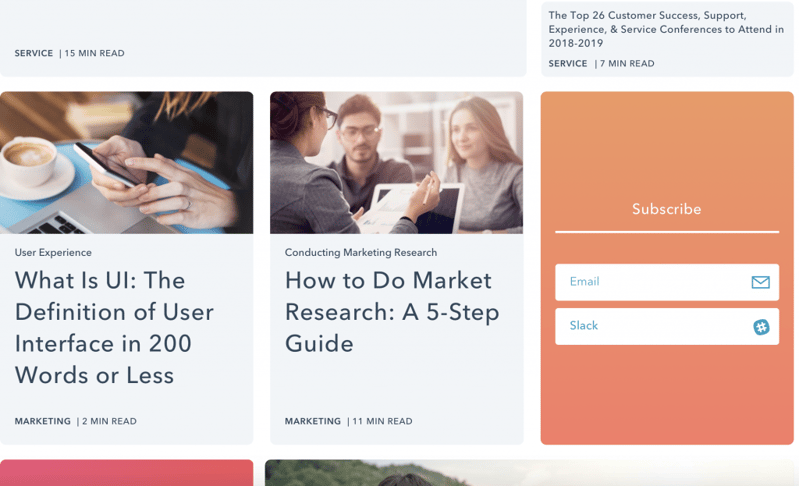 Hubspot has a subscription box that's quite visible and colorful.
Hubspot has a subscription box that's quite visible and colorful.
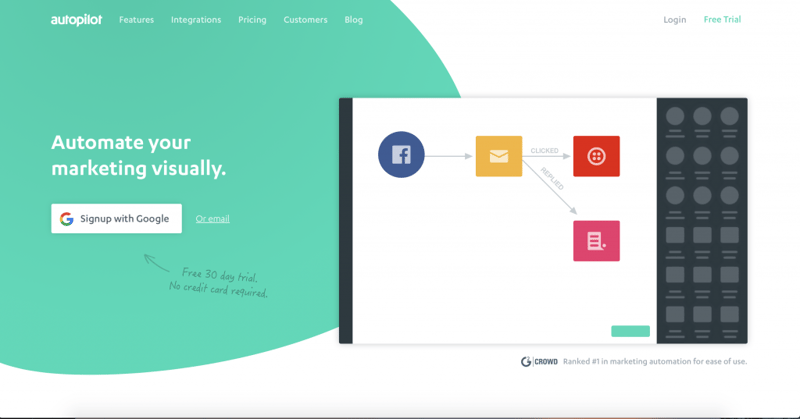 We love this homepage from Autopilot - so simple and inviting.
We love this homepage from Autopilot - so simple and inviting.
2. Make your CTA's clear and visible
This sounds pretty straightforward, but you’d be surprised at how frequently B2B sites don’t put CTA’s in the forefront (this is particularly common among businesses who don’t have marketing as their primary focus - yet). Sometimes, on certain websites, our digital team will play a game to see who can spot the CTA first – sort of like ‘Where’s Waldo’ but with serious lead-gen repercussions.
Your visitors aren’t likely to spend an additional minute to find where they can subscribe to your content… and at that point, you will have lost them. Help your visitors so that they don’t have to dig through your website to reach a subscription box. Insert them in your navigation menu, sidebar, use a pop-up, top bar installment or a slideup – anything to make sure that your visitor encounters your offer. Although there are some contradicting opinions whether or not the pop-up is annoying, the success rate is impressive since you simply can’t miss it!
Here’s a few good examples.
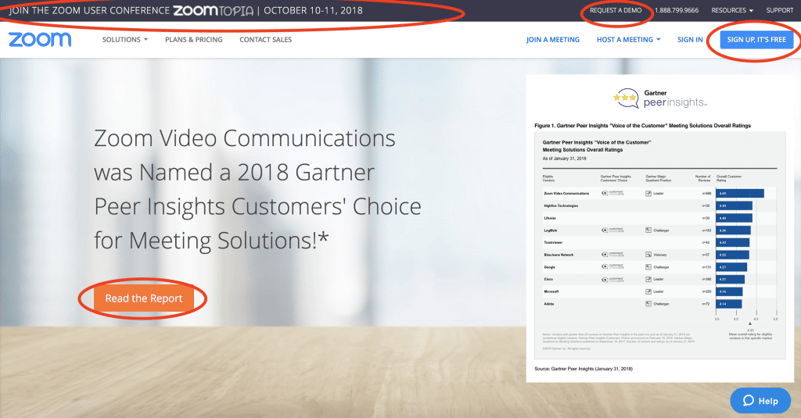 Zoom has not 1, 2 but 4 very visible CTA’s on their homepage. They have a top bar to call out for the ZoomTopia event, a free report, and demo CTA’s. It’s hard to miss these.
Zoom has not 1, 2 but 4 very visible CTA’s on their homepage. They have a top bar to call out for the ZoomTopia event, a free report, and demo CTA’s. It’s hard to miss these.
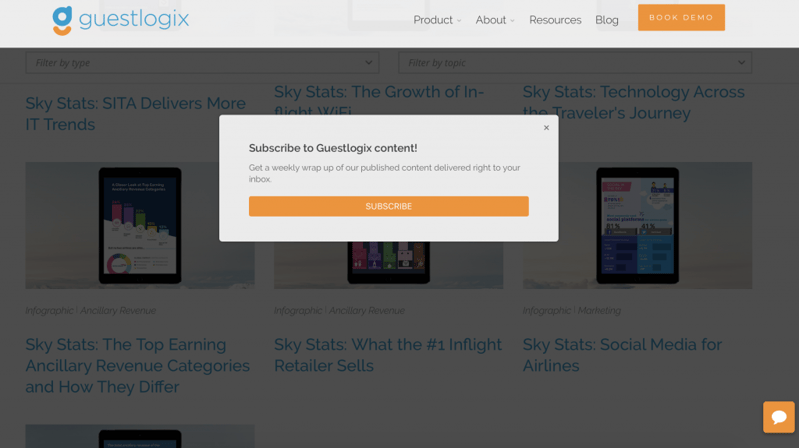 See, a pop-up bar is impossible to miss! :) You’ll see one on Guestlogix’s blog and resources page.
See, a pop-up bar is impossible to miss! :) You’ll see one on Guestlogix’s blog and resources page.
3. Give them a reason to sign up - a tempting offer
It’s year 2018… Everyone has too many emails in their inboxes and too much content to filter through. As a result, we’re no longer tempted to sign up for more newsletters or blogs and increase the weight in our inboxes unless we really feel passionate about the brand or we believe we’ll get value out of this connection.
If you want to pique interest and create a reason to motivate your visitors to sign up, attach a free offer - something that is valuable to your prospects. After all, you’re asking for something of value – an email address of a potential prospect. It’s only good business sense to offer something of value in return.
Here are some possible incentives you can offer visitors to sign up – and you’ve likely seen many of these before:
- An ebook, industry brief or whitepaper
- Webinar/video
- How to guide
- Podcast series
- Early access to something
- 15-min consultation call
- Demo
An additional tip: While you’re planning your offers, think of the different stages your prospects may be in - are they in the awareness phase or have they moved further down the sales funnel? Consider offering an ebook, guide or email series for those that are top-of-funnel, and a consultation call or a demo session for those who are further along.
4. Ask what they’re interested in receiving
The reason why most email lists don’t work well is because they are not relevant. Eventually, this results in little to no engagement, or unsubscribes – the primary symptom of ‘decaying database syndrome’.
Consider the questions a visitor might have in their head when presented with an opportunity to connect with your business. When signing up, what exactly do they sign up for? Will they receive a notification for every blog post? News about events? Product updates? Can they select the industries they’re interested in? Help them be precise with what they want to hear from you so they don’t get bored and leave you.
Imagine if a contact is still in their exploratory phase, learning about your business, and you send them a product update. Do you think they would find it relevant, or would they roll their eyes and possibly unsubscribe because they’re not ready yet?
Providing options in your CTA’s is a great way to categorize and understand your subscribers. You can put them in your relevant lists and send them the information they’ve actually signed up to receive.
 Hubspot is the the king of giveaways and lead generation, period. And they have a very clean form where the reader can select the type of insights they want to sign up for.
Hubspot is the the king of giveaways and lead generation, period. And they have a very clean form where the reader can select the type of insights they want to sign up for.
5. Keep your sign-up link handy and promote it
Have you ever heard that you need to spend as much time (if not more) promoting your content as you spend creating it? Well, that rule applies to your sign-up link as well. Once you’ve decided to grow your subscription list, make sure to have the link handy and promote it on all relevant platforms. Most email providers will have a landing page or a URL for you to copy and share on different platforms. If you’re using Mailchimp, you can easily get your sign-up form link by following these steps.
When you have your URL, some of the ways you can promote it are:
- Hyperlinking in email signatures of your team
- Inserting the link in sales decks
- Share on social media - pin it to your profile page for exposure whenever someone is on your page (this applies to Linkedin and Twitter)
- Insert a Sign Up button on your Facebook Page
- Encourage subscribers to share and forward your emails by including social sharing buttons and an "Email to a Friend" button
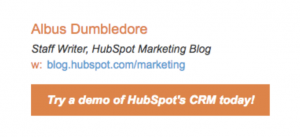
Over to you...
Was your database affected by the GDPR too? Did you use any of these methods (or others) to grow it back? Have you found them helpful? Let us know through sending comments or start a conversation with us on social media. You can find us on Facebook, Linkedin and Twitter with the handle @meetthinkink.
Whether downsized by GDPR or not, the contact database is a valuable asset for businesses and the challenge to grow a healthy and engaged list is real. With this said, email marketing should be an integral part of any marketing strategy and proves its effectiveness in the work we do with our clients every day. If you’d like to learn more about how we can help you with your B2B marketing and lead generation needs, we’d love to hear from you.
And while we’re on topic, here’s how you can sign up to receive our marketing insights via email each month.
Sign up for our insights on the convergence of business and PR





